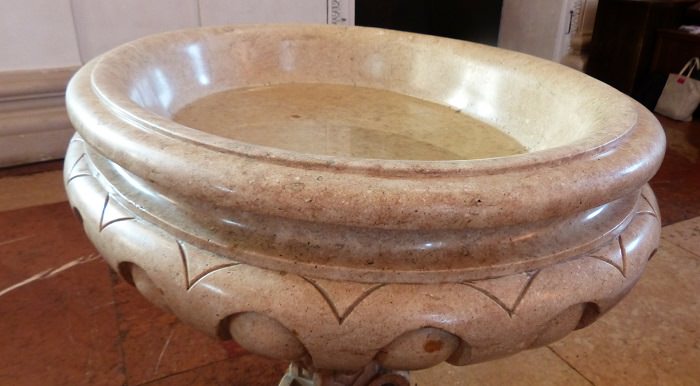 Una semplice ricerca del termine “battesimo” nel Vecchio Testamento non trova nessun riscontro.
Una semplice ricerca del termine “battesimo” nel Vecchio Testamento non trova nessun riscontro.
Comunque, nel momento in cui Giovanni Battista approda sulla scenza e comincia a destare il popolo e convocarlo per “il perdono dei peccati”, (Marco 1:4) le persone sembrano avere già un intendimento di cosa fosse il battesimo. Infatti sembra che ci siano state altre forme di battesimo praticate a quel tempo oltre quello di cui parlò Giovanni e poi Gesù. In particolare, la domanda che viene fuori sembra essere su chi sta effettuando il battesimo e con quale autorità. Nessuno sembra invece preoccuparsi su quell’azione in se stessa – come se comprendessero già la questione. Poiché il Vecchio Testamento non sembra parlarne esplicitamente e il Nuovo Testamento invece lo introduce improvvisamente con ogni persona che sembra comprendere che tale pratica esiste, che cosa è accaduto fra i due testamenti? La pulizia rituale era comune a qualche setta ebrea intorno la fine di quella epoca. Uno dei migliori esempi di questo viene da Khirbet Qumran – dove sono stati rinvenuti diversi miqvot usati per una specia di “battesimo”. E’ comunemente ritenuto che le persone che viveva a Qumran fossero Esseni, e qualcuno ha speculato che Giovanni Battista potesse essere uno di loro o di un gruppo simile. La comunità di Qumran cominciò leggermente intorno quella epoca continuando nel I secolo d.C. così fu contemporanea di Gesù. Il termine inglese “battesimo” è una parola presa i prestito derivata dal termine greco βάπτισμα e βαπτισμός. Entrambi questi termini greci sono correlati al verbo βαπτίζω, da cui deriva il verbo inglese “battezzare” anch’esso un termine preso in prestito. L’equivalente ebreo del termine inglese “battesimo” e del termine greco βαπτισμός è il termine טְבִילָה, (tevila), correlato al verbo טָבַל (taval),che significa segnatamente “tuffare”. Il Dottor Ernest Klein scrisse sull’associazione tra il battesimo e l’immersione. Heinrich Friedrich Wilhelm Gesenius scrisse che nel vecchio Testamento lo stesso termine viene impiegato per significare una forma battesimale. Senza scendere in troppi dettagli, nel Vecchio Patto si parla di un battesimo di pulizia, (Numeri 19:11). Dopo essere stati spruzzati con “l’acqua della separazione”, (creata dalle ceneri di una giovenca rossa), il terzo e il settimo giorno del suo stato di essere immondo, (per avere toccato un corpo morto o altro), l’israelita doveva lavare i suoi abiti in acqua e e immergersi in acqua, (כִבֶּס בְּגָדָיו וְרָחַץ בַּמַּיִם) e poi al calar del sole sarebbe stato mondo, (Numeri 19:19), Il testo Ebreo usa la coniugazione del verbo רָחַץ (rachatz).
Questo verbo occorre 72 volte in 71 versi. Mentre è spesso usato per “lavare” e qualche volta per “far il bagno”, l’atto del bagno consisteva nell’immergersi in un mikve, (piscina di acqua) per potere diventare mondi dopo esser stati immondi.
Ripreso da christianity – adattato da Pastore Gabriele Paolini
A simple word search for “baptism” in the Old Testament turns up no matches. However by the time John the Baptist shows up on the scene and starts dunking people and calling it “for forgiveness of sins” (Mark 1:4) people seem to already have an understanding of what baptism is.
In fact, it seems there might have been other sorts of baptisms practiced at the time other than what John and later Jesus talked about. In particular the questions that pop up seem to be about who was doing the baptizing and on what authority. Nobody seems be too concerned about the act itself — as if it was a well understood thing already. Since the OT doesn’t seem to speak of it and the NT jumps right in with everybody seeming to understand that such a practice exists, what happened in between the Testaments? Ritual cleansing was a common part of some Jewish sects around the turn of the era. One of the best examples of this comes from Khirbet Qumran — where there were found severalmiqvot used for a sort of “baptism.” It is commonly held that the people living at Qumran were Essenes, and some have speculated that John the Baptist may have been a part of this group or one similar to it. The Qumran community began slightly before the turn of the age and continued into the early 1st century CE, so it was roughly contemporaneous with Jesus. The English word “baptism” is a loanword derived from the Greek words βάπτισμα and βαπτισμός. Both of these Greek nouns are related to the Greek verb βαπτίζω, from which is derived the English verb “baptize,” also a loanword. The Hebrew equivalent of the English noun “baptism” and the Greek noun βαπτισμός is the noun טְבִילָה (tevila), which is related to the verb טָבַל (taval), essentially meaning “to dip”. Dr. Ernest Klein wrote about the association betwween baptism and immersion.Heinrich Friedrich Wilhelm Gesenius wrote that in the Old Testament the same noun was employed to indicate a sort of baptism. Without go throug many details in the Old testament it has been recorded about a baptism ordered for cleaning up, (Numbers 19:11). After being sprinkled with the “water of separation” (created with the ashes of the red heifer) on the third and seventh day of his uncleanness, the Israelite was to “wash his clothes and bathe in water” (וְכִבֶּס בְּגָדָיו וְרָחַץ בַּמַּיִם), and then he would be clean after sunset (Numbers 19:19). The Hebrew text use a conjugation of the verb טָבַל (rachatz).
This verb occurs 72 times in 71 verses. While it is often translated as “wash” and sometimes as “bathe,” the act of bathing consisted of immersing in a mikve (pool of water) in order to become clean after contracting uncleanness.
Drawn from Christianity – adpted by Pastor Gabriele Paolini
Sostieni la redazione di Notizie Cristiane con una donazione, clicca qui























